In this article we’ll discuss and compare four popular flooring materials, that is Vinyl, Laminate, Ceramic Tile and Hardwood, so let’s get started.
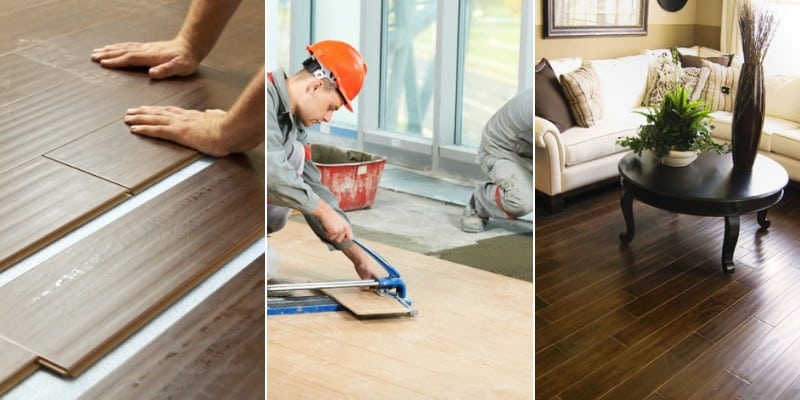
Description of Vinyl Material Flooring
It’s been around for nearly 60 years and you won’t find a more inexpensive way to spruce up your floors, so if vinyl flooring is your choice of material, count on Popular Mechanics to fill you in on why you should invest in this quintessentially popular option.
You get the warmth of hardwood and elegance of ceramic tile but it’s the plastic content in vinyl that does the hard work of making vinyl flooring easy to maintain.
Given such a long evolution, it should come as no surprise that you’ll find vinyl to suit your aesthetic, style and budget (from regular types to luxury vinyl planks for a more sturdy floor).
The manufacture of vinyl flooring is a science miracle. Polyvinyl chloride (PVC) is mixed with various compounds that add sheen, hardness, color and patterns and when this mix of chemicals reaches the proper temperature, it is spread out via rollers that flatten and smooth the mix into sheets.
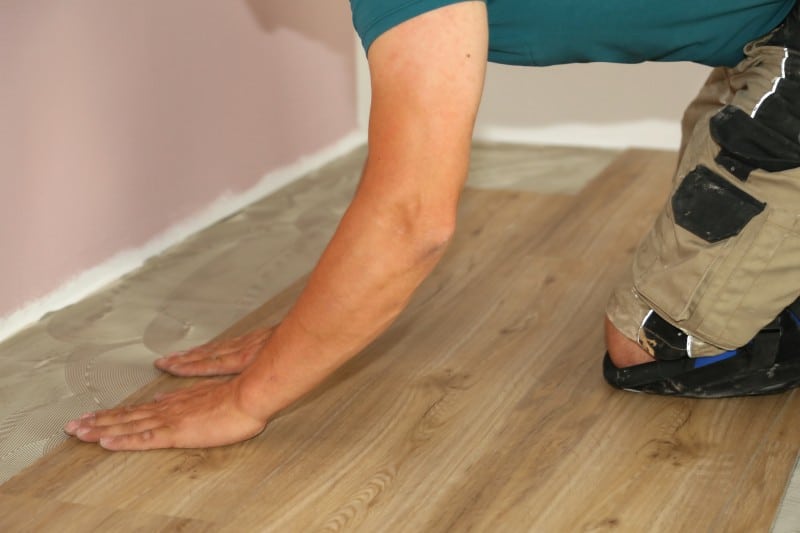
Once dried via heated air, vinyl receives a felt backing that’s around 25 mils thick and given a coating of clear PVC sealer before it is spun onto a gigantic spool so it can be cut to order. Vinyl planks are the newest additions to coverings that belong to this flooring niche.
Description of Laminate Flooring
Having learned that vinyl is a composite of materials that allow you to cover your floor in one seamless application at an affordable price, you might be surprised to learn that laminate is also an amalgam of materials, say the BestLaminate.com flooring experts.
“Real wood is combined with other materials to create a strong, durable surface.” Manufacture is undertaken as a four-layer process that, once constructed, produce durable floor sections that look awesome and also protect your floors from everything from foot traffic to liquid spills.
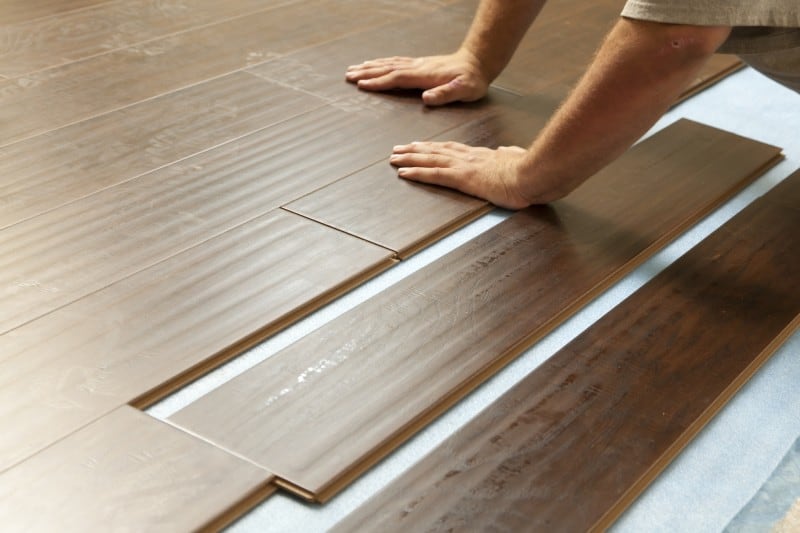
Imagine making a 4-ingredient sandwich to understand how these sections are fabricated. At the bottom of the sandwich is a layer of backing that creates the water barrier you need to keep excess moisture, mold and mildew at bay.
Next, a thick inner wood pulp core is attached to the backing before a high-definition printing process creates 4 layers of paper patterns that, when bonded, produce the look of hardwood or tile. Once attached, high or direct pressure bond the layers before a clear topcoat is added.
How can you tell whether the laminate you choose is high or low quality? Find out whether it’s Direct Pressure Laminate (DPL) and High-Pressure Laminate (HPL).
DPL only applies between 300 and 500 pounds (per square inch) of pressure during the production phase while HPL delivers 1300+ pounds of pressure.
The more pressure, the higher quality. Are you aware of the fact that laminate is a relatively eco-friendly flooring choice? It’s manufactured of recycled wood chips and fibers, so if you seek an environmentally responsible floor, laminate may meet your criteria.
Description of Ceramic Tile Flooring
Don’t confuse ceramic and porcelain tiles, though the two are first cousins, say professionals at Floorings International. “Porcelain tile flooring is actually just a subset of ceramic tile flooring,” but that’s where commonalities end.
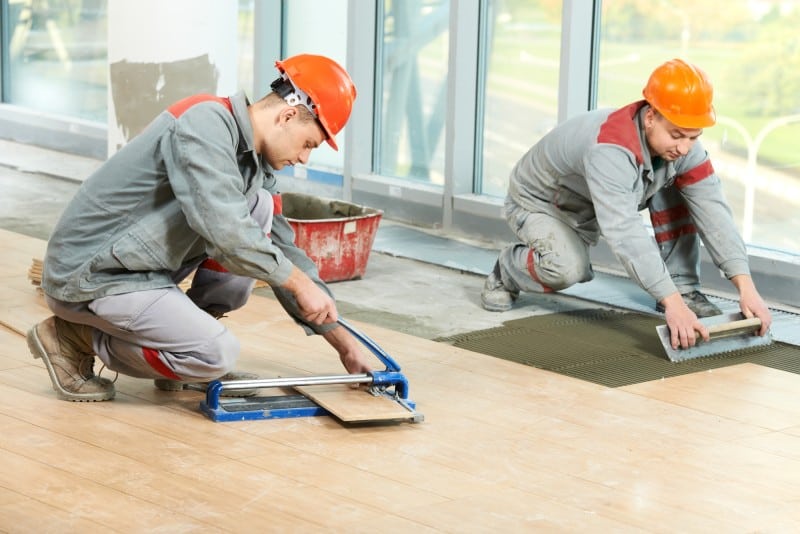
Ceramic tiles are fashioned of clay, painted and glazed before going into the kiln to be fired while porcelain tiles require a more feldspar-enriched clay that must be fired at a higher temperature than ceramic (as much as 1350-degrees F).
Ceramic tile isn’t as dense as porcelain and it has a higher absorption rate, but it’s a cheaper alternative to porcelain. As a result, it’s not frost-proof but it is easier to damage and chip.
That stated, ceramic remains a very popular choice for all sorts of surfaces that go beyond floors and patios and include countertops and walls.
The special ceramic glaze used on tiles before firing them protects and seals individual tiles and contributes to beautiful colors and patterns.
Perhaps the most often-cited reason for choosing ceramic over porcelain tiles is the price. Ceramic tile comes in just as many beautiful patterns, styles and colors but it won’t eat up your entire budget if you choose it.
Description of Hardwood Flooring
Décor experts agree that wood flooring came into vogue in the 1600s when dirt or stone were covered with unfinished planks held up by wood joists in some of the most elegant homes of the era.
This includes French palaces like Versailles. With roots deeply imbedded in French décor, parquet and marquet patterns became the most desired wood flooring style around 1625.
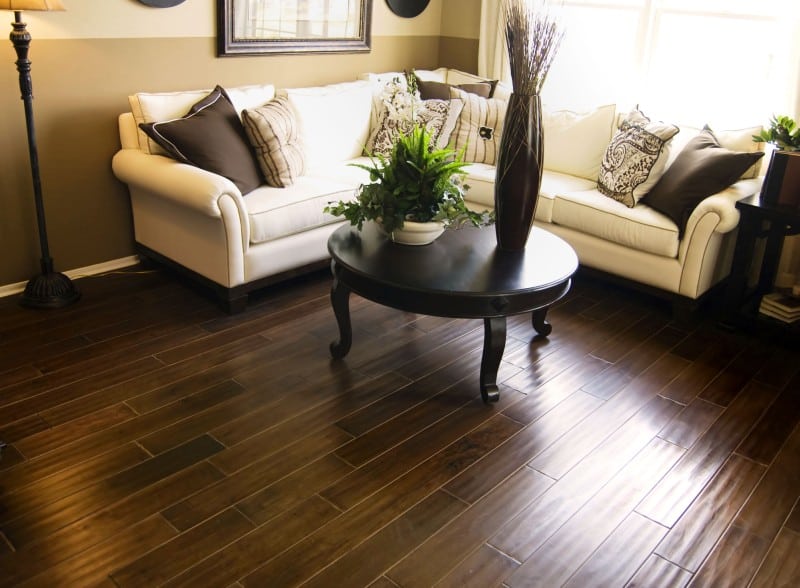
These hand-crafted floors took enormous time and effort to install because every piece of wood had to be hand-scraped, rubbed in sand, stained and polished to bring up the grain and sheen. It’s been 800 years since those floors were installed and they’re still gorgeous.
Hardwood floors grew in popularity throughout the world. By the Victorian era, no home on either side of the Atlantic went without hardwood flooring thanks to a burgeoning industry of factories and sawmills that mass produced wood planks.
These were lined up and tacked down using brads and then scraped and sanded with 25-pound blocks to smooth the floor until it was uniform before being varnished and buffed.
Today’s wood flooring industry has diversified. From the advent of tongue and groove construction to new methods of refinishing individual planks, the world has come full circle as repurposed wood and bans on unethical logging practices continue to make hardwood popular albeit one of the most expensive flooring materials of all.
Vinyl vs Laminate Flooring: Which is a better choice for you?
We turn to the savvy flooring experts at The Spruce, a popular website dedicated to all things home-related, to help us determine ways these two types of floors behave and perform.
For starters, it’s important to know that vinyl is made completely of synthetic materials and comes in both sheet and plank forms that range between 1.5mm and 5mm thicknesses.
Laminate flooring is made of wood byproducts that are bonded with resin. The thinnest laminate is still thicker than vinyl because the thickness range runs between 6mm and 12mm.
Not every floor is best served by choosing laminates because this material doesn’t combat moisture as well. Vinyl can be installed everywhere. It’s not a good idea to install laminate in a bathroom, mudroom or laundry room because moisture can deteriorate this material.
In terms of appearance, if you’re going for realism, vinyl can’t compare to laminate when it comes to replicating wood, ceramic or stone facades. It can even show off the three-dimensional embossing that can’t be replicated in even the priciest vinyl.
Why is laminate a bad choice for areas like bathrooms and kitchens? Water acts to soften and swell this material and once warped, it isn’t likely to return to its former shape or look.
Vinyl on the other hand can be completely immersed in water and for an extended period of time. Yet once dried, it retains its original shape and show no sign of damage. In sum, vinyl is not just water-resistant but waterproof, too.
Here’s good news if you’re looking to justify the laminate you have fallen for: both of these floors are easy to clean, though laminate is best suited to dry mopping and sweeping while vinyl can be scrubbed and there’s no restrictions on products you can use.
Laminate installation requires an understanding of how the click-and-lock system works and for custom cuts, you’ll need a circular or table saw with a fine tooth blade.
While vinyl planks may also feature click-and-lock systems, you’ll pay more for this material. Cost comparisons are relatively identical.
Plan to spend around $1 per square foot for laminate planking that’s 7mm-thick to $5 per square foot for 12mm-thick planks.
Vinyl also runs about $1 per square foot for the thin, glue-down version while thicker planks cost about $5 per square foot. Warranties on laminates typically run between 10 to 25 years while vinyl warranties average 20 years.
Vinyl vs Ceramic Tile Flooring: Which is a better choice for you?
Homeowners and professionals seeking to compare vinyl with ceramic tiles most often base their judgements on vinyl planks rather than sheet vinyl, which is why we follow suit.
There’s no mistaking the popularity of vinyl planks for a long list of reasons. First, vinyl planks are kinder to budgets and as the engineering of this plank style advances, this option is becoming even more desirable.
Further, it is likely to cost you around 40-percent less to install vinyl planks over ceramic tile because the aforementioned click-and-lock install system is so much less complicated than the labor-intensive process required to lay tile that includes everything from surface prep to grouting and sealing.
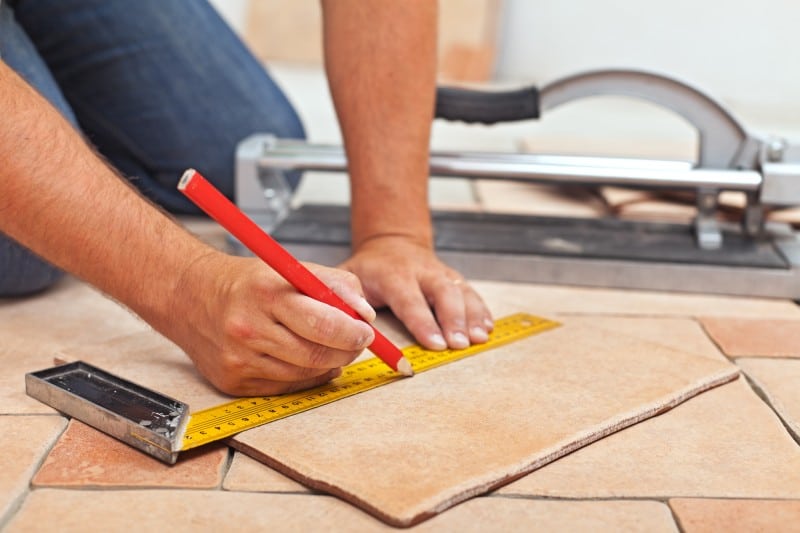
Experts estimate that a vinyl plank install is 60-percent quicker than undertaking a ceramic tile job, but both ceramic tile and vinyl planks are equally durable options given the same amount of traffic to which each is subjected.
That stated, only ceramic tile can chip, crack and be damaged inadvertently, so if you have active kids and pets and lots of foot traffic, ceramic tiles may not be your best option.
If you’re factoring cost, estimate between $4 and $8 per square foot for ceramic tiles if you’re doing the job yourself.
Add $5 per square foot for labor. You can expect to spend much less on vinyl.
According to Fixr.com, the average, per-square-foot cost of vinyl ranges between $2-$8 per square foot, and that includes labor costs.
Further, you will have to rip up your existing flooring to install a ceramic tile floor and that can create endless amounts of dust, not to mention breathing in loosened bonding agents. Removing ceramic tiles is a time-consuming, laborious job requiring patience!
Laminate vs Ceramic Tile Flooring: Which is a better choice for you?
When Kevin McDermott was asked to compare laminate v. ceramic tile flooring for Hunker.com, he began his comparison by writing that “Both ceramic and laminate flooring are essentially imitations of nature.”
He refers, of course, to the organic nature of both materials, fired stone tiles and laminates made of pulverized and shaped woods.
But here’s where ceramic tiles shine, notes McDermott: “Ceramic can last almost indefinitely” while laminates may not survive more than 20 years.
Additionally, he says that “the installation process for ceramic flooring can feel like it lasts forever, while installing laminate flooring is almost as simple as rolling out a throw rug.”
Further, ceramic wins the hardness comparison while laminate won’t fare well in high-moisture areas because core wood materials are soft and porous.
The labor-intensive nature of installing ceramic tiles can be daunting and includes grouting, sealing and drying.
This can take days, while a saw and a free afternoon may be all you need to install a laminate floor. “It snaps together like a puzzle,” he adds.
While a decent ceramic floor could set you back between $4 and $8 per square foot — add $5 per square foot for labor — you could spend as little as $1 to $3 per square foot on laminate if you install it yourself.
Once both are down, maintenance is relatively easy. Use mild cleansers and a damp mop to keep laminates looking good and while sealed ceramic tiles are also relatively easy to clean with a mop and cleaning product, grout cleaning is no picnic.
On a final note, ceramic can chip and crack if something heavy is dropped on it, but substituting a pristine tile left over from the original install can take care of that if you don’t mind digging out the old one.
Conversely, if laminated floors sustain damage, McDermott says that “there’s no practical way to patch it or do a partial replacement,” citing the interlocking nature and fabrication of these planks.
Laminate vs Hardwood Flooring: Which is a better choice for you?
Cost savings are one of the biggest factors people choose laminate over hardwood. Further, the DIY market has adopted laminate because it is easy to install, and you don’t have to remove existing flooring to install it.
Additionally, the number of cleaning products on today’s market for laminates has multiplied. No detergent-based cleaners, please, or you could leave a dull film on your laminate floor.
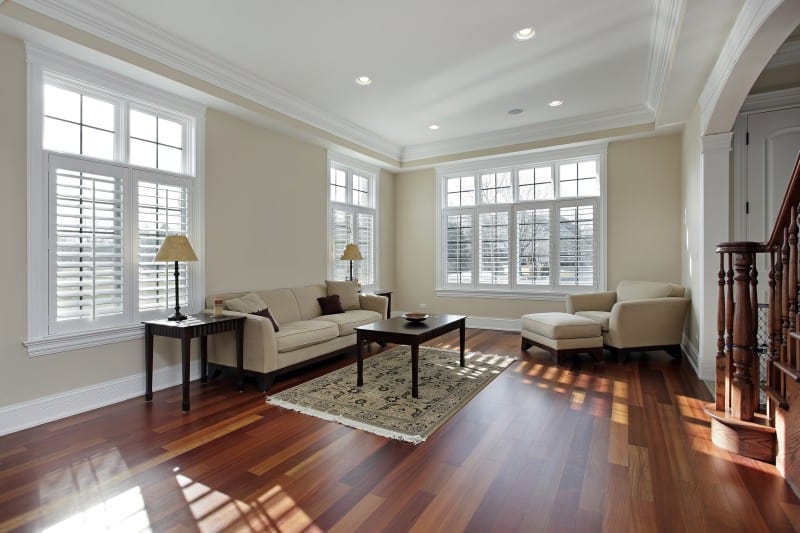
Having considered the merits of affordable, easy-to-care-for, good looking laminate, it’s time to turn to hardwood floors that remain the epitome of natural beauty and elegance.
Today’s hardwood choices are expansive; they are available in so many textures, types, colors and finishes, early pioneers hewing lumber for cabins and floor materials would likely be stunned to see this much variety!
Why would anyone turn down an authentic wood floor? Because the features and benefits beloved by many include negatives, too.
Easily marred, even sealers can’t guarantee that a hardwood floor will escape dents, scrapes and damage as a result of ordinary traffic patterns and hardwood reacts dramatically to intense sunlight that can alter the floor’s color.
If only a portion of a hardwood floor is exposed to sun, faded splotches can look even worse.
But in this day and age of all things green and sustainable, you won’t find another product that’s as environmentally responsible and a niche has arisen in the flooring industry that promotes the use of reclaimed wood.
Should you decide on a floor made of rescued wood and take pride in the fact that it is harvested responsibly (especially if it has received Forest Stewardship Council (FSC) certification), you get bragging rights in addition to a gorgeous look.
All of your cleaning tools work on hardwood: broom, mop, wax, hardwood floor polish and myriad products on today’s market. But, be prepared to open your wallet wide.
According to HomeAdvisor researchers, “Hardwood flooring costs between $2,497 and $6,753 or an average of $4,538 or $8 per square foot.”
Add between $6 and $12 per square foot for labor and in case you’re fortunate enough to belong to the “spare no expense” crowd, your contractor could easily bill between $13 to $25+ per square foot for the install. Is this investment worth the expense? That’s for you to decide!
Related Posts
- Different Types of Finishes That Make Concrete Floors Aesthetically Appealing
- 10 Main Pros and Cons of Acid Stained Concrete Floors
- 3 Methods to Remove Candle Wax From Your Carpet (With Iron, Hair Dryer, Natural Products)
- 13 Types of Carpets for Your Home (By Material, Pile, Padding)
- How Much Does it Cost to Epoxy a Garage Floor? All Details Below
- 20 Different Types of Tiles for Home Flooring, Walls, Countertops, Backsplash
Leave a Reply